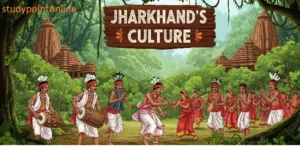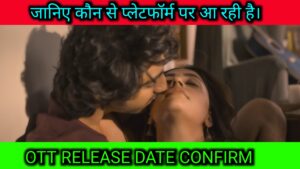Jharkhand’s Culture: Folk Dances, Festivals, and Traditions
Jharkhand, often referred to as the “Land of Forests”, is not only rich in minerals and biodiversity but also in cultural heritage. Known for its vibrant tribal traditions, folk dances, music, and festivals, Jharkhand’s culture forms an important part of Static GK for competitive exams like UPSC, JPSC, JSSC, and SSC CGL. Understanding the cultural aspects of Jharkhand can give you an edge in exam preparation while also deepening your appreciation for the state’s unique identity.

1. Overview of Jharkhand’s Cultural Identity
Jharkhand is a state in eastern India that was formed on November 15, 2000, the birth anniversary of tribal leader Birsa Munda, from the southern part of Bihar. The state is home to over 32 tribal communities, each contributing to its diverse culture. Its name translates to “the land of forests,” and forests and woodlands cover over 29% of its area. The state is bordered by Bihar to the north, Uttar Pradesh and Chhattisgarh to the west, Odisha to the south, and West Bengal to the east.
Key Facts:
- Capital: Ranchi
- Sub-capital: Dumka
- Area: 79,714 sq km, making it the 15th largest state in India.
- Population (2011 Census): 32.96 million, with Hindi as the official language.
2. Folk Dances of Jharkhand
Folk dances are integral to Jharkhand’s cultural life. They are often performed during harvest seasons, festivals, and social gatherings. These dances not only entertain but also preserve history and traditions.
- Chhau Dance: A semi-classical dance form with martial and folk traditions. It is recognized by UNESCO as an Intangible Cultural Heritage. The Seraikella style of Chhau is specific to Jharkhand.
- Paika Dance: A ceremonial martial dance performed by men, featuring swords and shields. It is a tribute to the valor of the Paika warriors.
- Jhumair Dance: A popular folk dance performed during the harvest season and festivals. There are different variations, such as Mardana Jhumair (for men) and Janani Jhumair (for women).
- Domkach: This is a folk dance traditionally performed during marriage ceremonies and other festivals.
- Firkal: A martial art folk-dance of the Bhumij tribes, which involves the use of swords, arrows, bows, and shields.
- Fagua: A dance performed by both men and women during the festival of Holi.
- Karam Dance: A tribal dance associated with the Karam festival, where the community worships the sacred Kadamba tree.
- Mundari Dance: A popular dance form of the Mundari community, often performed during harvest seasons and festivals.
- Santhali Dance: A group dance performed by the Santhal tribes, expressing their joy and cultural practices.
Exam Tip: In SSC CGL and State PSCs, questions on “Which folk dance belongs to which state” are common. Remember that Chhau, Jhumar, Paika, and Domkach are linked to Jharkhand.
3. Major Festivals of Jharkhand
Festivals in Jharkhand reflect its tribal ethos, agricultural cycles, and religious diversity.
- Karma Festival – Celebrated in August-September, it honors the Karam tree, symbolizing fertility and prosperity.
- Sarhul – Marks the beginning of the New Year for tribal communities; celebrated with the worship of the Sal tree.
- Tusu Parab – A harvest festival in January, featuring folk songs and community gatherings.
- Bandna – Celebrated post-harvest, where cattle are decorated and worshipped.
- Hal Punhya marks the first day of the agricultural season.
- Sohrai – A harvest festival celebrated in November, coinciding with Diwali, honoring cattle and agricultural gods.
- Bhagta Parab – A festival celebrated between spring and summer seasons, known for its extreme physical feats and worship of Buddha Baba.
Note: These festivals are often included in Static GK questions under “State Festivals”.
4. Languages and Literature
Languages of Jharkhand
- Indo-Aryan Languages: Hindi, Khortha, Nagpuri, Kurmali, and Panchpargania
- Dravidian Languages: Kurukh (Oraon) and Malto (Paharia)
- Austroasiatic (Munda) Languages: Santali, Mundari, Ho, Kharia, and Bhumij
Literary Traditions
- Oral Literature: Jharkhand’s literary tradition is primarily oral, with folk songs, tales, proverbs, and epics passed down through generations, reflecting the tribes’ values, beliefs, and way of life.
- Written Literature: Modern literature in Jharkhand began to develop in the early 20th century, with the Parnashakhi movement led by poets like Dukhiram Mahto, Suresh Chandra Mahto, and Laxmi Narayan Munda.
- Script Development: Scripts like Ol Chiki (Santali) and Tolong Siki (Kurukh) have played a significant role in promoting written literature in Jharkhand.
Famous Writers and Works
- Dr. Ram Dayal Munda: A renowned linguist and intellectual from the Munda tribe, known for his work on Adivasi identity and culture.
- Vishwanath Sahdeo and Shiv Khera: Notable writers who have enriched Jharkhand’s literary tradition.
- Dayamani Barla: A poet and activist who writes in Santali, known for her collection of poems “Dharti Aai” (Mother Earth).
- Hansda Sowvendra Shekhar: A novelist and short story writer who writes in Hindi, known for his novel “The Man Who Was a Woman” ² ³ ⁴.
Themes in Jharkhand Literature
- Tribal Identity: Exploring the experiences and struggles of tribal communities.
- Nature and Spirituality: Reflecting the deep connection between humans and nature.
- Social Issues: Addressing challenges like displacement, industrialization, and women’s roles in society.
5. Traditional Music and Instruments
Music is a vital part of Jharkhand’s social functions. Traditional instruments include:
- Mandar – A drum used in most tribal dances.
- Tumdak – A two-sided drum used in Santhali performances.
- Bansuri – A bamboo flute, common across India, but with local folk tunes.
- Nagara – A large kettledrum, played during festivals.
6. Art and Craft
Jharkhand’s art is deeply symbolic, with motifs inspired by nature and daily life.
- Paitkar Paintings – Known as “scroll paintings”, they often narrate mythological stories.
- Sohrai Art – Wall paintings made with natural colors, especially during the Sohrai festival.
- Bamboo and Cane Craft – Used to make baskets, mats, and decorative items.
- Dokra Art – Metal casting using the lost-wax technique, creating tribal figurines and ornaments.
7. Cuisine of Jharkhand
The cuisine is simple yet flavorful, often prepared with locally sourced ingredients.
- Dhuska – Deep-fried rice and lentil pancakes.
- Chilka Roti – Rice flour roti served with chutney or curry.
- Rugra – A seasonal mushroom delicacy.
- Handia – A traditional rice beer, made with a fermentation starter called ranu.
For exams: Questions on “state cuisine” are rare but can appear in culture-based descriptive answers.
8. Important Personalities in Jharkhand’s Cultural History
Knowing key personalities is useful for both Static GK and history sections.
- Birsa Munda – Freedom fighter and tribal leader.
- Jaipal Singh Munda – Hockey captain of India’s 1928 Olympic gold medal-winning team and political leader.
- Raghunath Murmu – Creator of the Ol Chiki script for the Santhali language.
9. Jharkhand’s Culture in Competitive Exams
In exams like SSC CGL, UPSC, JPSC, and JSSC, Jharkhand’s culture appears in the following ways:
- MCQs on folk dances, festivals, and languages.
- Descriptive questions on tribal traditions and art forms.
- Static GK questions linking festivals with seasons or crops.
Tip: Make short notes with keywords like “Chhau – Seraikela – UNESCO” or “Sarhul – Sal tree – New Year” to revise quickly before exams.
10. Spirituality of Jharkhand
Jharkhand is home to numerous temples that showcase the state’s rich cultural heritage and spiritual significance. Here are some of the most famous temples to visit:
Major Temples
- Baidyanath Temple: Located in Deogarh, this temple is one of the twelve Jyotirlingas and a major pilgrimage site, especially during the Shravan Mela.
- Jagannath Temple: Situated in Ranchi, this temple is a replica of the famous Jagannath Temple in Puri and is known for its annual Rath Yatra festival.
- Basukinath Temple: Dedicated to Lord Shiva, this temple in Dumka district is famous for its evening Aarti and is a significant pilgrimage site.
- Chhinnamasta Temple: Located in Ramgarh district, this temple is dedicated to Goddess Chhinnamasta and features Tantrik-style architecture.
External Resources & Further Reading
For readers who want to explore more about Jharkhand’s rich culture, traditions, and history, here are some valuable external resources:
- Culture of Jharkhand – Wikipedia
- Official Website of the Government of Jharkhand
- Know India – Ministry of Culture, Government of India
- Ministry of Tribal Affairs, Government of India
- National Portal of India
Conclusion
Jharkhand’s culture is a vibrant blend of tribal traditions, festivals, folk dances, and artistic expressions. For aspirants of UPSC, JPSC, JSSC, and SSC CGL, this knowledge is essential for the Static GK section and also enriches descriptive answers in Mains. By learning the folk dances, festivals, languages, and art forms of Jharkhand, you’re not just preparing for exams but also preserving and promoting the cultural heritage of the state.



